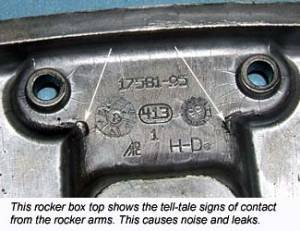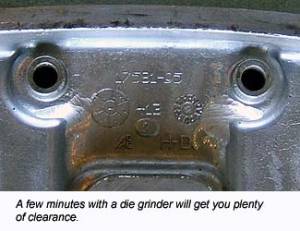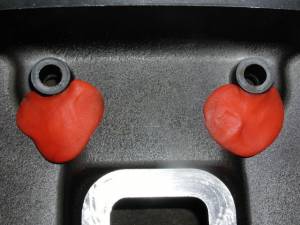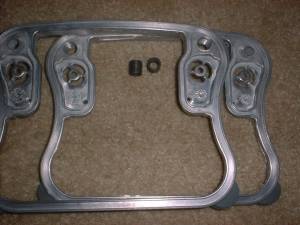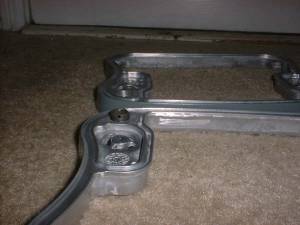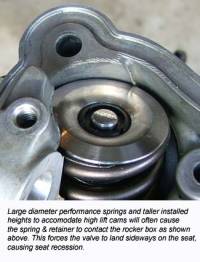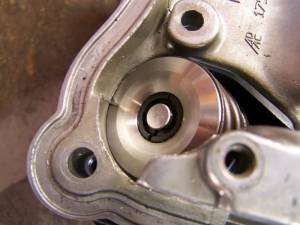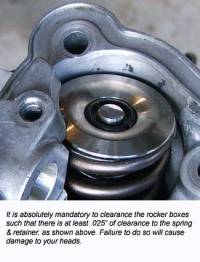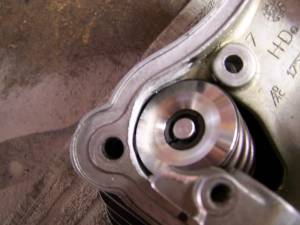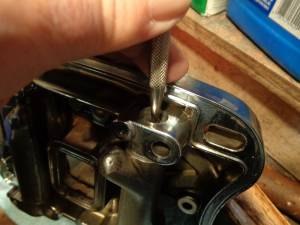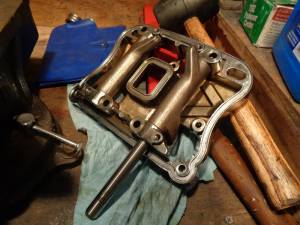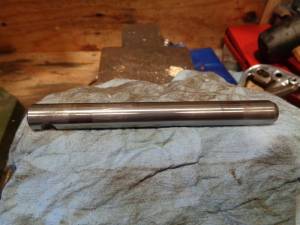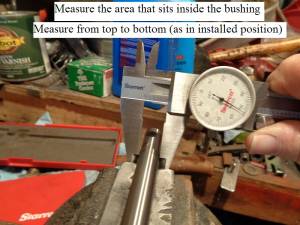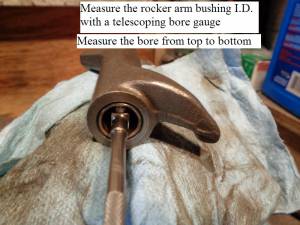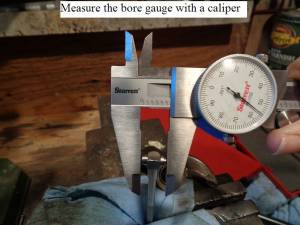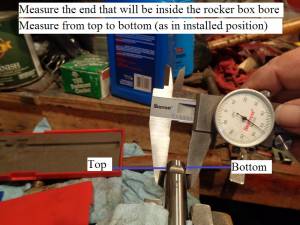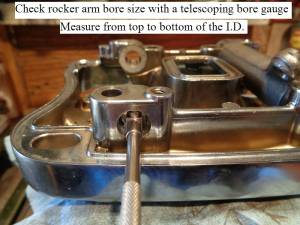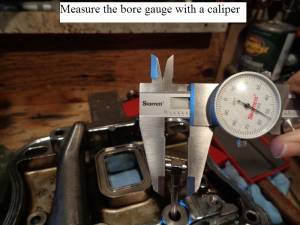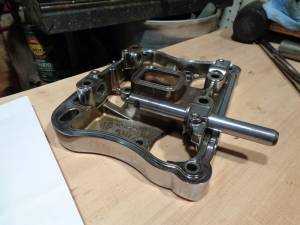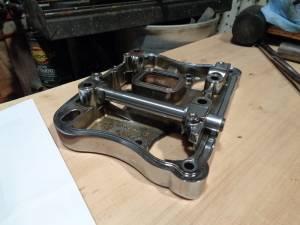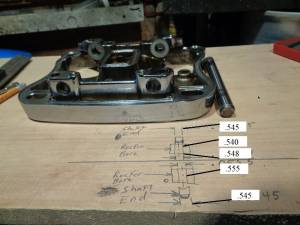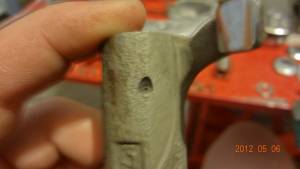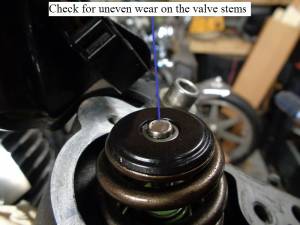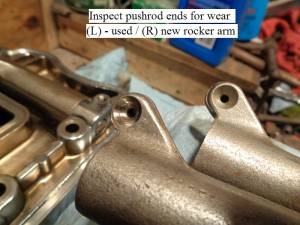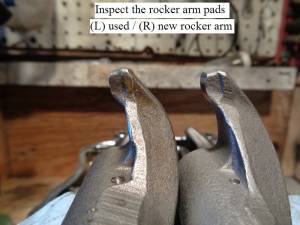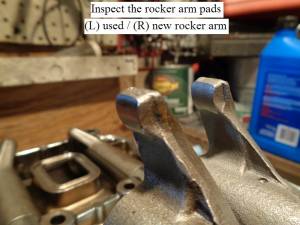Table of Contents
This is an old revision of the document!
EVO: Engine Mechanicals - Sub-04B
Rocker Box / Rocker Arm Inspection and Servicing
See also in the Sportsterpedia.
Clearancing the Rocker Boxes
High lift cams or changes in the valve springs can cause contact in the rocker box. 1)
When you have high lift cams, as the rockers push your valves open they are also putting a sideways pressure on the valve stems. 2)
Even if you haven't installed performance parts or have acquired a bike that you're unfamiliar with;
Inspecting the rocker boxes can clue you in to possible problems from wear before it's too late.
If something were to wear down or overheat or come lose for instance. 3)
Worn valve guides can also offset the spring travel and let them hit the covers. 4) 5)
When using bronze valve guides, they are cut shorter to allow for valve clearancing.
That causes the valve guides to wear out in an hour glass shape.
When the valve retainers hit the rocker boxes it pushes the valves sideways and wears out the inside of the valve guides faster than usual.
Adding clearance in the rocker box is not described in the FSMs since the factory took care of that when they built it. 6) 7)
But it's incredibly important with OEM modifications or a performance build to check clearances in the rocker box.
Anytime you deviate from factory setups, it's not optional to overlook this step.
Unfortunately, it's also one of the hardest steps to get people to pay attention to.
Professional mechanics will sometimes skip this step (or take it lightly) more than non-professionals do.
Take this seriously.
Upper Rocker Box / Cover (All)
Check the clearance between the rocker arm and the underside of the rocker box cover. 8)
With high lift cams, the rocker arm will often make contact with the rocker box top.
You can use a little play-dough or modeling clay to check this clearance.
Place it in the areas as in the pic below, install it and turn the engine over.
Then remove the cover and see if anything got up intp the clay and where.
Pull the tops and look for little marks on the inside. 9)
There shouldn't be any outside of factory casting marks.
Rocker or pushrod contact will appear as marks that shouldn't be there.
If any are found, a little strategically located grinding cleans it right up.
Occasionally, 536 cams can cause the rocker arms to hit the rocker box tops (on the pushrod side).
This is rare, but it can happen.
Contact here should cause any damage, but it'll cause noise and leaks. 10)
A lot of rocker box top leaks have been traced to this.
Middle Rocker Box Spacer (91-03)
This is a mod to curtail the issue of puking oil out the breathers. 13)
86-90 engines do not have a crankcase breather valve incorporated into the rocker boxes.
However, the first answer would address other known factors for wet sumping.
This mod consists of;
Chamfering the umbrella hole to 60 degrees (included angle),
And drilling out the existing drain back hole to 1/8“.
To the extent the drain back hole is enlarged, it bypasses the umbrella valve.
Maybe 1/8” isn't enough to cause an issue,
But the umbrella valve is what keeps the air inhalation/exhalation to a minimum,
And inhalation/exhalation is what carries oil out the breathers.
So you don't want to bypass it any more than necessary.
You could probably do the chamfer, but not the drain hole enlargement.
Then, if you still have the issue, you could also drill out the drain hole.
The rocker box middles use the same casting for both the front and rear cylinder.
And there's a facility for the umbrella valve on both ends of each middle spacer.
So you can try this, and if it doesn't work, just move the umbrella valve to the other end and use the rocker box middle on the other cylinder.
In other words, this mod is undo-able, a one time thing.
The umbrella hole is the one in the middle of the picture below.
The drain back hole is the tiny little hole to the right of the sideways 13 in the picture.
Another suggestion is to enlarge the tiny oil drain from ~.070 to .09375 and add threaded inserts as oil standoffs. 15) 16)
Looking at the pictures below, you can see 3 holes that are in a roughly oval shape area in the corners of the middle rocker box cover. (2 per rocker box, only 1 is used per cylinder)
With each downstroke, the air in the crankcase is forced thru the umbrella valve.
The air has an oil mist in it.
The oil is supposed it settle out in this little chamber and drain back to the cylinder head thru the tiny oil (bottom of oval area).
Slightly enlarging the little hole lets the oil drain back easier.
Air that enters this oval(ish) chamber has to go somewhere.
So it goes out the big hole on top, thru the breather bolts and out.
The threaded insert just provides a lip around the hole.
So any oil that drops out of suspension around the hole won't drain out the breather.
It just makes it a little bit harder for oil to go out the breather.
The inserts below were left overs from another project.
You can use anything that does the same thing.
You can buy a product online called “Slobber Stoppers”. https://www.ebay.com/itm/200917426709
It comes with threaded barrels similar to the threaded inserts below to eliminate oil mist from getting into the air cleaner.
Lower Rocker Box / Cover (All)
The most critical clearance in the rocker box is the clearance between the valve springs and all areas of the rocker box around it. 19)
If the valve spring or retainer is allowed to touch the rocker box, it forces the valve to land sideways on the seat.
This causes seat recession and the resultant loss of seal, which of course saps power among other things.
Performance springs are larger in diameter than the factory springs and they will generally want to touch the rocker box.
You absolutely must provide a minimum of .025“ of clearance all around the valve spring and retainer.
Grind or file on the rocker box as needed to achieve this clearance.
Note that with a beehive spring pack, this probably won't be an issue, but check it anyway.
With a conventional straight wound performance spring pack, it will almost certainly be an issue.
Check for clearance issues between the valve spring / collar and the rocker box. 20)
When running big springs and cams, the additional lift can run the springs into the inside edge of the rocker.
In that case, the rockers should be clearance for the bigger springs.
This is more than just a nuisance noise. It will cause valve seat recession.
This means pulling the heads and changing seats, an expensive proposition.
That's one of the nice things about the 7mm valves with beehive springs in the late heads, it eliminates this problem.
| Lower rocker damage from valve spring impact 21) | ||
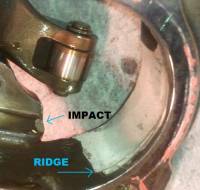 | 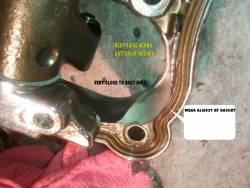 | 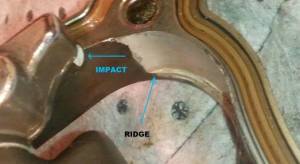 |
Valve spring clearance is a very common issue with high performance straight wound springs. 22)
Back before we went to beehive springs, this was a major headache for us.
People would lose valve seal and swear up and down they clearanced their rocker boxes adequately.
But later on, we'd get their rocker boxes and find spring/retainer gouge marks in them.
No matter what we did, we just couldn't get people to take it seriously.
If those springs hit the insides of the rocker boxes, you WILL get recessed valve seats, not maybe.
This issue went away when we migrated to beehives, thankfully.
It was a major motivating factor behind finding beehives that would work.
But they're not really suitable for all applications in HD motors.
Of course, now we're moving beyond beehives to the next great thing.
What you're looking for is to make sure the spring cannot contact the side of the box.
The clearancing can be done with a drum sander on a dremel type rotary tool 23) or a die grinder.
| Big springs can cause this issue. 24) | The clearancing job doesn't have to be pretty. You're just creating space for the springs to miss the rocker. 25) |
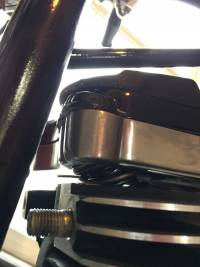 | 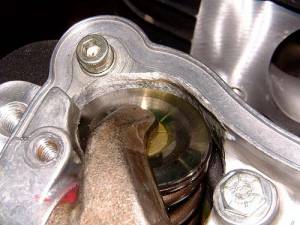 |
You can use a Sharpie marking pen or other to mark where the springs are too close so you'll know where to relieve the rocker box.
Rocker Arms
The rocker arm shaft is not supposed to rotate from it's installed position.
The shafts have a notch in them that the bolt is supposed to butt up against which locks the rocker arm shafts in place. 30)
However, the bolt hole is too large which leaves a gap there.
This gap allows the shaft to slightly rotate and hit the bolt which causes an annoying ticking/tapping noise.
Normally what rotates is the rocker arm itself.
The bushings in the rocker arm pivot around the rocker arm shaft.
The shaft runs through bushings on both ends of the rocker arm.
These bushings can expand due to normal wear.
The FSM suggests visual inspection and measuring of specific clearances as outlined below as a guide to when to replace parts.
Ultimately, it's an individual judgment call as to replacing parts that are within measured specs.
Rocker Arm Specs
Service wear limits are a guideline for measuring parts that are not new.
Replace parts when their measurements exceed the wear limits below.
If wear limits are not given for a part, refer to the new install specs. 31)
| Rocker Arm Specs | New Install | Used Service Wear Limits |
| Shaft in bushing (loose) | .0005” - .0020“ (.013 mm - .051 mm) | .0035” (.089 mm) |
| End play | .003“ - .013” (.08 mm - .33 mm) | .025“ (.64 mm) |
| Bushing fit in rocker arm (tight) | .004” - .002“ (.10 mm - .05 mm) | No variance |
| Rocker Arm Shaft Specs | New Install | Used Service Wear Limits |
| Shaft fit in rocker cover (loose) | .0007” - .0022“ (.018 mm - .056 mm) | .0035” (.089 mm) |
Inspection before removal
Check the end play of each rocker arm
The ends of the rocker arms can wear down the area where they touch the lower rocker box.
- Push the rocker arm to one end.
- Check the clearance between the other end and the cover with a feeler gauge.
- The FSM suggests to replace the rocker arm or lower cover or both if the end play exceeds .025“ (.63 mm). 32)
| Checking end play 33) | |
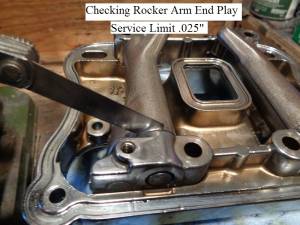 | 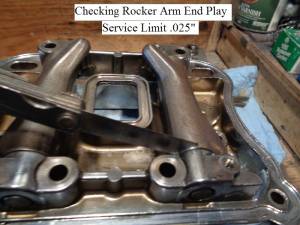 |
Inspection after removal
If the rocker arm shafts will not slide out on their own;
You can remove them by tapping them out using a hammer and a soft metal punch. 34)
You'll be measuring for an 'out of round' condition of the rocker arm and associated parts.
Most of the wear in the rocker arm shafts and bores results from up and down movement of the pushrods and valves. 35)
This can result in an out of round condition on either or all of these parts.
(more wear in the top and bottom than the sides)
When measuring the rocker arm shaft end, it's bushing or cover bore when new,
Take a measurement and then turn 180° and take another measurement.
The two measurements should be the same in newly installed parts.
Subsequent wear will happen from top to bottom and need replacement.
This could induce noise and expedite wear on the parts.
Check the shaft in bushing clearance
All measurements should be taken from the top to bottom position as each part sits while installed as per the FSM.
That is where most of the wear will be as mentioned above.
- Measure and record the rocker arm shaft dia. at each bushing area with a caliper.
- Measure and record the I.D of the rocker arm bushing with a telescoping bore gauge and caliper.
- Subtract the shaft dia. from the bushing I.D. and match that number against the wear limit specs.
- If the bushing is at or past the service wear limit, proceed to “replacing the bushings” as in below.
Check the shaft fit in the rocker cover
An assembly bolt runs through the gap near the end of the shaft.
The gap is wider than the bolt.
This allows a slight movement of the shaft in it's rocker cover bore.
You can check for slight movement there on a running engine: 36)
With the covers off, draw a straight line with a felt marker on the end of the shaft from the cover bore and down the shaft.
Then fire up the engine. At idle, if you see any back and forth movement of that line, you have movement of the shaft.
Checking the shaft fit is the same as checking the bushing clearance;
All measurements should be taken from the top to bottom position as each part sits while installed as per the FSM.
That is where most of the wear will be as mentioned above.
- Measure and record the dia. of the rocker arm shaft at each rocker bore with a caliper.
- Measure and record the I.D of the rocker box bore for the shaft with a telescoping bore gauge and caliper.
- Subtract the shaft dia. from the rocker box bore and match that number against the wear limit specs.
- If the either are at or past the service wear limit,
- Check the dia. in the middle of the shaft against the dia. at the end. Both places should be the same.
If the shaft is smaller in dia. on the end, replace the shaft and recheck the measurements.
(this is cheaper than replacing the lower rocker cover) - If the shaft mic's out OK, then replace the lower rocker cover.
Check the oiler hole in the exhaust rocker arm
The exhaust side rocker arms have one tiny little hole that the intake rockers don't have. 37)
This tiny little hole is for extra oiling for cooling exhaust side.
While you have the rocker arms out,
You can use a welding tip cleaner or other small wire to poke down this hole to clean or verify the hole is clear.
Visual Inpections
Inspect the valve stems
- Look at the condition of the valve stems in the heads.
This will give you an indication of how the rocker pad is wearing against the valves.
Check for pitting or uneven wear.
Inspect the rocker arm ends
- Inspect both the rocker arm pad and pushrod end for uneven wear or pitting.
Replace the rocker arm if either exist.
Rocker Arm Bushing Replacement
Replace the rocker arm bushings one at a time.
- Press or drive the bushing out of the rocker arm.
- If the bushing is difficult to remove, thread a 9/16”x18 tap into the bushing.
Then, from the opposite end, press or gently knock the bushing / tap out of the rocker arm.
- Press the replacement bushing into the rocker arm flush with the arm end.
- Place the split portion of the bushing towards the top of the arm.
- Line ream the bushing using rocker arm bushing reamer (94804-57).
- “Jims” also makes this tool. You can find it online.
- Use the remaining old bushing as a pilot hole (to keep center).
- Once you've got the new bushing reamed, repeat the procedure for the bushing on the other end.
- This time, you'll use the new (reamed) bushing as a pilot hole to ream the second bushing.
| “Jims” makes this reamer for the rocker arm bushings. It is referenced to HD part number (94804-57) 40) |
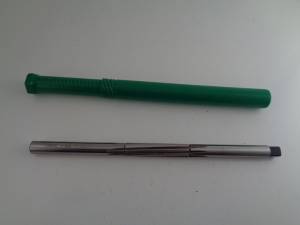 |
Rocker Lockers
As for the ticking/tapping noise mentioned above,
Some people rather like the noise and others don't.
The shafts have a notch in them that the bolt is supposed to butt up against which locks the rocker arm shafts in place. 41)
However, the bolt hole is too large which leaves a gap there.
This gap allows the shaft to slightly rotate and hit the bolt which causes an annoying ticking/tapping noise.
There are no provisions from the MoCo for this gap to be used for oiling or to control heat.
It's a closed gap inside the lower rocker arm bore.
Heat control is done by way of clearances in the bushings as well as the drilled hole in the exhaust rocker arms.
Aftermarket spacers are made to close the gap between the bolts and the shafts.
Several different ones are made and you can find them on the internet.
One of them is called “Rocker Lockers”. 42)
The Rocker Lockers eliminate the gap.
This locks the shaft from turning and striking the bolt and eliminates the ticking noise.
They also center the rocker plate so that it is always located in the same position.
This helps to eliminate different wear patterns on the rocker arm/valve and a better alignment of the pushrod in the holes.
The Rocker Lockers are tapered so that they lock themselves in and wedge the bolt/shaft in place.
Note:
Rocker Lockers will not quiet noisy lifters, noisy chains, gears, tensioners or bearings.
If you ever need to remove the lockers, just use a punch and tap them out, they are usually reusable.
- The 86-06 Sportster kit includes: 43)
- (4) Brass tapered bushings
- (1) Bolt, Washer & Nut for installation
- (1) Teflon centering tool
- Step-by-step installation instructions
- The 07 and Up Sportster kit includes: 44)
- (4) Brass tapered bushings
- (1) Washer & Nut for installation
- (1) Teflon centering tool
- Step-by-step installation instructions

